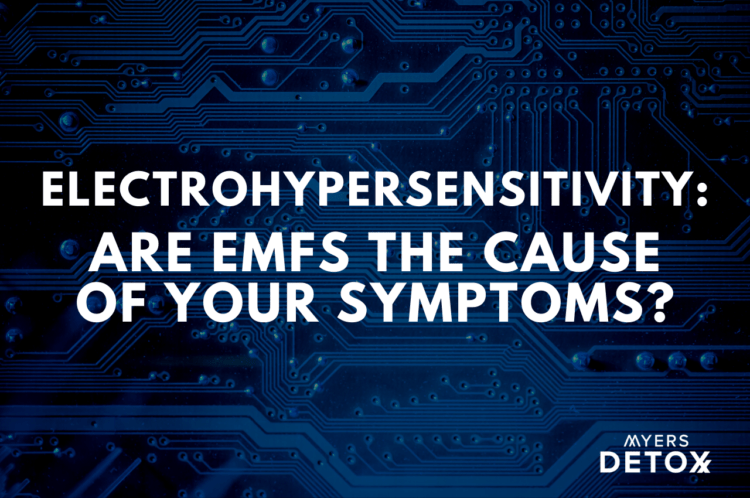Electrohypersensitivity: Are EMFs the cause of your symptoms?

EMFs (also known as electromagnetic frequencies) are increasing in your environment every year, and for some people, sensitivity to these frequencies can result in a myriad of symptoms called electrohypersensitivity. Learn more, including some simple steps you can take to protect yourself from EMFs, in this article…
As the world gets more tech-savvy, our lives have become a lot more efficient. No longer do we have to pull out a map when we want to take a trip somewhere. And what about waiting for the internet to connect? It better not take more than five seconds.
While all of these advances can be seen as beneficial and time-saving, they don’t come without their downfalls.
Beyond the ease of life with increased levels of technology in our world, there is a hidden potential danger — EMFs.
In this article, you’ll learn:
-
What is electrohypersensitivity?
-
How EMFs impact the health of your cells
-
Common symptoms of electrohypersensitivity
-
Health concerns related to electrohypersensitivity
-
What puts you at risk for electrohypersensitivity
-
How to protect yourself from electrohypersensitivity
-
The ultimate tool to assist in your battle against EMFs
What Is Electrohypersensitivity?
Electrohypersensitivity is a term used to describe the physical reaction that many people are experiencing to EMF (electromagnetic field) exposure. For those that are sensitive, EMF exposure can cause a whole slew of symptoms that can come on aggressively, but in most cases, slowly increases in intensity due to exposure over time.
EMFs are fields of energy that emanate from your electronic devices. They emit low levels of radiation, which over time, can result in adverse health effects like fatigue, difficulty concentrating, nausea, burning sensations, and more.
Everyday devices like cell phones, computers, televisions, internet routers, WiFi, and Bluetooth appliances all emit low levels of EMFs that can have detrimental impacts on your health[1].
How EMFs Impact Your Health
Research into the harmful effects of EMFs goes back to the 1990s, where researchers began to notice a correlation between electronic devices and patients reporting adverse health effects. While more research needs to be conducted to uncover exactly how harmful EMFs are, there is a general understanding of how these frequencies might affect your body on a cellular level[2].
The primary route for EMF damage, as we currently understand it, is through something called reactive oxygen species (ROS), also known as free radicals. ROS are chemical compounds that are naturally produced by your body as a normal part of your biological process. In the everyday wear and tear of your body, you will create low levels of ROS, which are balanced out by your antioxidant systems.
The issue with ROS occurs when the amount of ROS you’re exposed to outweighs your antioxidant defenses. When this happens, something called oxidative stress occurs — and this is where things can get dangerous.
Oxidative stress can damage essential parts of your cells, such as proteins, fatty acids (in your cell membrane), and DNA. This impairs the way your cells function and can have a snowball effect when reactive oxygen species go unchecked[3].
Electromagnetic frequencies induce above average amounts of oxidative stress by interrupting cellular respiration. During this process, oxygen is utilized in the process of creating energy molecules for your body to use. When electromagnetic frequencies interfere with the normal process it liberates oxygen, and can result in oxidative stress[17].
Another way that EMFs can affect your body is through disruption of your voltage-gated calcium channels(VGCC). Your VGCC initiates many biological effects by creating an electrical charge on the membrane of your cells, moving calcium in and out of the cell. Cell signaling, gene expression, and secretion of neurotransmitters are just a few of the processes regulated by your VGCC[19]. In other words, EMFs make your cell membranes more permeable and more vulnerable to pathogens.
EMFs can also interrupt your own biofield, which is the field of energy within and around your body. This is the main way that your body communicates. The body’s energy field governs physical functioning. EMFs interruption of your body’s natural frequencies can throw off your communication mechanisms leading to a breakdown in physical function and the resultant host of symptoms[18].
Research shows that exposure to EMFs can affect heart rate, and heart rate variability. Your heart creates an electrical impulse – the heartbeat. The nonnative EMF frequencies interfere in this electrical aspect of your body’s functioning.
Common Symptoms of Electrohypersensitivity
Electrohypersensitivy can show up in a variety of ways, but often affects the neurological systems in your body. Some of the most common symptoms associated with EMF exposure and electrohypersensitivity include[3][4]:
-
Headaches
-
Nausea
-
Dizziness
-
Ringing in the ear
-
Digestive issues
-
Heart palpitations
-
Mood Issues
-
Fatigue
-
Poor concentration
-
Brain fog
-
Impaired learning
-
Sleep disorders
-
Loss of appetite
Who Is At Risk For Electrohypersensitivity?
Due to the broad range of symptoms that can be attributed to electrohypersensitivity, it can be difficult to pinpoint whether or not it is EMFs that are instigating these harmful effects. EMFs are everywhere in your environment; it’s almost impossible to escape them, so determining whether or not you’re sensitive can be a tricky process.
There are, however, certain conditions that may make you more susceptible to electrohypersensitivity, namely any condition that is marked by a poor inflammatory response or oxidative stress.
Since EMFs instigate the process of oxidative stress, which often results in notable inflammatory factors that affect your health if your immune defenses are already in high gear trying to combat these imbalances, it may make you more susceptible and sensitive to electromagnetic fields.
The Growing Problem With Electrohypersensitivity
While EMF exposure has been a topic of research for over two decades, the potentially harmful effects haven’t done anything to slow down the rate at which technology is advancing. As our phones and WiFi gets faster and more efficient, the amount of EMFs you’re exposed to steadily grows.
When once EMFs came solely from cell phones and powerlines, today, smart TVs, home surveillance systems, and even smart refrigerators are contributing to your everyday exposure. And unfortunately, this is likely only going to increase with the rollout of next generation EMF delivery systems. China is already working on 6G!
Then there are the satellites Elon Musk is launching into the atmosphere every month. Last month, 180 satellites were launched. By 2022, 20,000 satellites will be launched. Enter Bill Gates investment in SoftBank, which is also launch video surveillance satellites into space. All these will be emitting high frequency EMF.
EMF minimization and strategies will become more and more crucial as the digital wifi future continues to unfold at such a rapid pace.
So what are you to do?
Luckily, there are several ways that you can mitigate the damage of EMFs—starting with lowering your exposure and making some lifestyle changes.
How To Protect Yourself From EMFs and Ease Electrohypersensitivity
Here are some practical ways that you can begin to protect yourself from EMF exposure and subsequent electrohypersensitivity. While it may seem like a big list, you can try one or two at a time, and find what works best for you.
Keep in mind that these simple changes and are great healthy habits to practice regularly. However, the most effective way to protect against EMFs is to discover sources of EMFs in your home and eliminate them. Or turn your bedroom into a completely EMF safe haven. I’ll discuss that more in a future article.
Tips To Decrease EMF Exposure:
Unplug your WiFi at night
You don’t need to have their WiFi streaming while you sleep. Make a habit of turning your WiFi off at night, and allow your home to be EMF-free for a few hours every day. For extra credit, you can also choose to only turn your WiFi on when you need it. You can also set your wifi router in a timer to turn it off automatically when you go to bed. Additionally, there are wireless routers that turn off when you’re not using the wifi.
Hardwire with an ethernet plug
If you really want to avoid the EMFs that come from WiFi, forgo it altogether. Remember the days of dial-up internet? You can still plug your computer directly into your wall if you want to eliminate WiFi from your home.
Use airplane mode
When you’re not on your phone, turn it on airplane mode. Be sure to turn off the bluetooth feature too. This can be a great habit to get in while you sleep, or even during the day when you aren’t expecting calls. If you want to make sure that friends and family can get in touch with you in case of an emergency, set up a landline. I recommend turning off your phone a night, especially if it’s on the nightstand next to you.
Use your speakerphone
While Bluetooth can be a convenient hands-free way to communicate, it’s an EMF hotbed. When driving, or at home in a place where you won’t disturb anyone, use your speakerphone instead; this will distance your brain from the EMFs that are emitted from your phone. Do NOT hold your phone to your head!
Assess your smart devices
It seems like today, all of our devices are becoming “smart.” While this can make things easier in a lot of ways, smart devices require more EMFs than your standard devices. For this reason, assess whether you actually need your TV, refrigerator, etc. to be smart — or if the traditional version will still work for you.
Tips To Enhance Your Antioxidant Defenses:
As previously mentioned, the primary issue as we understand it today with EMF exposure is an increase in oxidative stress. Therefore, anything you can do to enhance your body’s ability to manage oxidation will help you in the battle against electrohypersensitivity.
Some antioxidant-boosting tips include:
Consume antioxidant-rich nutrients
One of the most direct ways to enhance your antioxidant status is to get them directly through the nutrients you eat. There are plenty of antioxidant-rich foods out there that can support your body in the fight against oxidative stress. Greens powders and veggies and superfoods can absorb and counteract radiation.
Some foods and herbs to focus on include[6][7][8][9][10][11]:
-
Broccoli sprouts
-
Turmeric
-
Moringa
-
Acai
-
Cinnamon
-
Green tea
Do a heavy metal detox
Perhaps one of the most beneficial ways to manage your oxidative stress is to detox your body of heavy metals. Heavy metals can create a toxic burden on your body, which is often exemplified by increased levels of oxidative stress and inflammation[12].
By incorporating nutrients that allow for heavy metal detox, you may assist your body’s immune system and relieve it of the burden that these metals can cause.
When you lower the amount of oxidative stress that your body deals with day to day, you’ll free up your existing antioxidant stores to manage any harmful effects from EMFs that you may be experiencing.
Additionally, if you’re high in heavy metals, these can act like a conductor that attract more EMFs to your body. Another reason to detox!
Manage stress
Many people put stress squarely into the emotional/mental category. However, emotional stress can have a significant impact on the health of your body. Research shows that when you’re under stress, the levels of oxidation in your body increase[13].
Therefore, practices like meditation, journaling, breathwork, exercise, and yoga can be helpful ways to manage oxidative stress caused by emotional stress[14][15][16].
The Ultimate Tool to Assist In The Battle Against EMFs
The above suggestions are a fantastic starting place when considering how to protect yourself against EMF radiation. I am all for setting up your home to be as anti-EMF as possible.
With that being said, EMFs are everywhere in the environment — not just your home. You can set up your home to be totally EMF free. It is possible. But how do you protect yourself when you’re out and about at work, at shopping malls, restaurants, and at friend’s homes?
Enter; the Harmoni Pendant. The Harmoni Pendant is a wearable pendant that goes with you everywhere. Research shows that it is able to reduce the stressful bodily effect of harmful EMFs by 48%. This personal EMF minimizing pendant travels with you wherever you go, giving you peace of mind that your body is protected to a large degree.
A recent study of the Harmoni Pendant showed that people enjoyed:
-
A 530% increase on average in energy
-
A 700% improvement on average in their heart rate variability score – a measure of stress
-
Enhanced regulation of the body’s autonomic nervous system on average by 310%
-
Improved bodily and circadian rhythms by an average of 160%
That’s pretty amazing!!
Designed with the scientific understanding of electromagnetic frequencies and sacred geometry, the Harmoni Pendant can also help you release negative energetic blockages in your field caused by physical and emotional stress.
This is why we’re hearing thousands people wearing the Harmoni Pendant report they have better sleep, more energy, feel less stressed and feel less effects from EMF. All with wearing a beautiful piece of functional jewelry.
Again, taking care of your home and the environments that you spend a good deal of time in is crucial in the battle to protect your body against the harmful effects of EMFs. However, this can quickly become complicated, expensive and frustrating. But it’s something that must be addressed.
I advise people to start with a Harmoni Pendant and then graduate to doing other things. So at least they are protected while investing in the learning curve to minimize EMF in their environment.
If you think you are dealing with electrohypersensitivity, there is no product or practice I recommend more than regular wearing of a Harmoni Pendant. I’ve worn my Harmoni Pendant for 3 years and I will NEVER take it off!
The product mentioned in this article is not intended to diagnose, treat, cure, or prevent any disease. The information in this article is not intended to replace any recommendations or relationship with your physician.
Click Here for References+
-
Belpomme, Dominique, and Philippe Irigaray. “Electrohypersensitivity as a Newly Identified and Characterized Neurologic Pathological Disorder: How to Diagnose, Treat, and Prevent It.” International Journal of Molecular Sciences 21.6 (2020): 1915.
-
Consales, Claudia, et al. “Electromagnetic fields, oxidative stress, and neurodegeneration.” International journal of cell biology 2012 (2012).
-
Kıvrak, Elfide Gizem, et al. “Effects of electromagnetic fields exposure on the antioxidant defense system.” Journal of microscopy and ultrastructure 5.4 (2017): 167-176.
-
Mihai, Cosmin Teodor, et al. “Extremely low-frequency electromagnetic fields cause DNA strand breaks in normal cells.” Journal of Environmental Health Science and Engineering 12.1 (2014): 15.
-
Uttara, Bayani, et al. “Oxidative stress and neurodegenerative diseases: a review of upstream and downstream antioxidant therapeutic options.” Current neuropharmacology 7.1 (2009): 65-74.
-
Bahadoran, Z., et al. “Broccoli sprouts reduce oxidative stress in type 2 diabetes: a randomized double-blind clinical trial.” European journal of clinical nutrition 65.8 (2011): 972-977.
-
MAITHILI KARPAGA SELVI, Nachimuthu, et al. “Curcumin attenuates oxidative stress and activation of redox-sensitive kinases in high fructose-and high-fat-fed male Wistar rats.” Scientia pharmaceutica 83.1 (2015): 159-175.
-
Wright, Racquel J., et al. “An investigation of the antioxidant capacity in extracts from Moringa oleifera plants grown in Jamaica.” Plants 6.4 (2017): 48.
-
Forester, Sarah C., and Joshua D. Lambert. “The role of antioxidant versus pro‐oxidant effects of green tea polyphenols in cancer prevention.” Molecular nutrition & food research 55.6 (2011): 844-854.
-
Tangvarasittichai, Surapon, et al. “Effect of cinnamon supplementation on oxidative stress, inflammation and insulin resistance in patients with type 2 diabetes mellitus.” Int J Toxicol Pharmacol Res 7.4 (2015): 56-59.
-
de Freitas Carvalho, Mayara Medeiros, et al. “Effects of acai on oxidative stress, ER stress, and inflammation-related parameters in mice with high fat diet-fed induced NAFLD.” Scientific reports 9.1 (2019): 1-11.
-
Flora, S. J. S., Megha Mittal, and Ashish Mehta. “Heavy metal induced oxidative stress & its possible reversal by chelation therapy.” Indian Journal of Medical Research 128.4 (2008): 501.
-
Schiavone, Stefania, et al. “Severe life stress and oxidative stress in the brain: from animal models to human pathology.” Antioxidants & redox signaling 18.12 (2013): 1475-1490.
-
Shohani, Masoumeh, et al. “The effect of yoga on stress, anxiety, and depression in women.” International journal of preventive medicine 9 (2018).
-
Esterling, Brian A., et al. “Empirical foundations for writing in prevention and psychotherapy: Mental and physical health outcomes.” Clinical psychology review 19.1 (1999): 79-96.
-
Wang, Huizhen, and Xin Zhang. “Magnetic fields and reactive oxygen species.” International Journal of Molecular Sciences 18.10 (2017): 2175.
-
Savitz, David A., et al. “Magnetic field exposure and cardiovascular disease mortality among electric utility workers.” American Journal of Epidemiology 149.2 (1999): 135-142.
-
Pall, Martin L. “Electromagnetic fields act via activation of voltage‐gated calcium channels to produce beneficial or adverse effects.” Journal of cellular and molecular medicine 17.8 (2013): 958-965.









